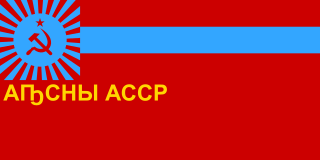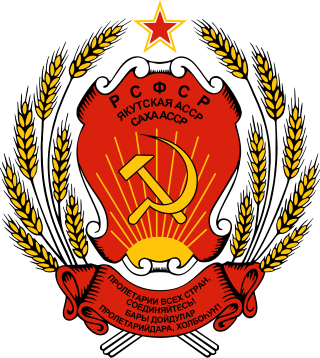
The State Flag of the Union of Soviet Socialist Republics, or simply the Soviet flag, was a red banner with two communist symbols displayed in the canton: a gold hammer and sickle topped off by a gold five-point star. The flag's design and symbolism are derived from several sources, but emerged during the Russian Revolution. It has also come to serve as the standard symbol representing communism as a whole, recognized as such in international circles, even after the dissolution of the Soviet Union in 1991.

The hammer and sickle is a communist symbol representing proletarian solidarity between agricultural and industrial workers. It was first adopted during the Russian Revolution at the end of World War I, the hammer representing workers and the sickle representing the peasants.

The Moldavian Soviet Socialist Republic or Moldavian SSR, also known as the Moldovan Soviet Socialist Republic, Moldovan SSR, or simply Moldavia or Moldova, was one of the 15 republics of the Soviet Union which existed from 1940 to 1991. The republic was formed on 2 August 1940 from parts of Bessarabia, a region annexed from Romania on 28 June of that year, and parts of the Moldavian Autonomous Soviet Socialist Republic, an autonomous Soviet republic within the Ukrainian SSR.

The flag of the Azerbaijan Soviet Socialist Republic was a plain red flag with a golden hammer and sickle and a gold-bordered red star in its upper canton and an horizontal dark blue band on the bottom fourth, representing the Caspian Sea.

The first flag of the Ukrainian Soviet Socialist Republic (UkSSR) was adopted on 10 March 1919 to serve as the symbol of state of the Ukrainian SSR. Details of the official flag changed periodically before the collapse of the Soviet Union in 1991, but all had as their basis the communist red flag. According to the decree of the Presidium of Supreme Soviet of Ukrainian SSR on 21 November 1949, the blue in the bottom "symbolises the mightiness and beauty of the people, and the blue banner of Bohdan Khmelnytsky".
The flags of the Soviet Socialist Republics were all defaced versions of the flag of the Soviet Union, which featured a golden hammer and sickle and a gold-bordered red star on a red field.

The emblems of the constituent republics of the Union of Soviet Socialist Republics all featured predominantly the hammer and sickle and the red star that symbolized communism, as well as a rising sun, surrounded by a wreath of wheat. The USSR State motto, Workers of the world, unite!, in both the republic's language and Russian was also placed on each one of them. In addition to those repetitive motifs, emblems of many Soviet republics also included features that were characteristic of their local landscapes, economies or cultures.

The Moldavian Autonomous Soviet Socialist Republic, shortened to Moldavian ASSR, was an autonomous republic of the Ukrainian SSR between 12 October 1924 and 2 August 1940, encompassing the modern territory of Transnistria as well as much of the present-day Podilsk Raion of Ukraine. It was an artificial political creation inspired by the Bolshevik nationalities policy in the context of the loss of larger Bessarabia to Romania in April 1918. In such a manner, the Bolshevik leadership tried to radicalize pro-Soviet feelings in Bessarabia with a goal to return it in the presence of favorable conditions and creation of geopolitical "place d'armes" (bridgehead) to execute a breakthrough in the Balkan direction by projecting influence upon Romanian Bessarabia, which was eventually occupied and annexed in 1940 after the signing of the Molotov–Ribbentrop Pact.

The Moldovan Cyrillic alphabet is a Cyrillic alphabet designed for the Romanian language spoken in the Soviet Union (Moldovan) and was in official use from 1924 to 1932 and 1938 to 1989.
Transnistria is a region in Eastern Europe that is under the effective control of the self-declared Pridnestrovian Moldavian Republic but is recognized by the international community as an administrative unit of Moldova, the Administrative-Territorial Units of the Left Bank of the Dniester.
Transnistria is a region in Eastern Europe that is under the effective control of the self-declared Pridnestrovian Moldavian Republic but is recognized by the international community as an administrative unit of Moldova, the Administrative-Territorial Units of the Left Bank of the Dniester.

The coat of arms of the Kazakh Soviet Socialist Republic was adopted on March 26, 1937, by the government of the Kazakh Soviet Socialist Republic. The coat of arms is based on the coat of arms of the Soviet Union.

The State Emblem of the Tajik Soviet Socialist Republic was adopted on March 1, 1937 by the government of the Tajik Soviet Socialist Republic. The emblem is based on the State Emblem of the Soviet Union. It shows symbols of agriculture. The red star is prominently featured with a small hammer and sickle within it. The rising sun stands for the future of the Tajik nation, and the star as well as the hammer and sickle for the victory of communism and the "world-wide socialist community of states". The emblem was replaced with the new emblem in 1992, which uses a similar design to the Soviet one. It was, however, was replacing the red banner with the current national flag, the big red star was replaced by the mountains, represents Pamir, the Samanid dynasty crown, and added the Quran book at below. It represents Islam as the official religion.

The coat of arms of the Moldavian Soviet Socialist Republic was adopted on 10 February 1941 by the government of the Moldavian Soviet Socialist Republic. The coat of arms is based on the coat of arms of the Soviet Union. It shows symbols of agriculture, an outer rim featuring wheat, corn, grapes and clover. The red banner bears the Soviet Union state motto in both the Romanian language and the Russian language. In Romanian, it was initially "Пролетарь дин тоате цэриле, униць-вэ!"; then, from the 1950s "Пролетарь дин тоате цэриле, уници-вэ!". Both are written in the Latin alphabet as "Proletari din toate țările, uniți-vă!". The acronym MSSR is shown only in Romanian in Moldovan Cyrillic ("РССМ"). The emblem was replaced on 3 November 1990 by the present coat of arms of Moldova. Currently, the unrecognized breakaway state of Transnistria uses a similar state emblem.
The coat of arms of the Moldavian Autonomous Soviet Socialist Republic was the official emblem of the Moldavian Autonomous Soviet Socialist Republic in the Soviet Union, and underwent a number of changes over time.

The flag of the Abkhaz Autonomous Soviet Socialist Republic was adopted in 1951 by the republic's government. Its primary visual features are identical to those of the flag of the Georgian Soviet Socialist Republic. A later version of the flag includes a gold inscription under the canton of the republic's name.

The flag of the Moldavian Autonomous Soviet Socialist Republic was created in 1925, when the All-Ukrainian Congress of Soviets approved the Constitution of the Moldavian ASSR, on 10 May. Thus, in Section VII, Article 48, the Constitution stipulated that: "The Moldavian ASSR has its own state emblem and flag, set by the Moldavian Central Executive Committee and confirmed by the Ukrainian Central Executive Committee". On 4 September 1925, the Presidium of the Central Executive Committee of the Moldavian ASSR discussed the issue "the contest for drafting the emblem and flag and its jury, consisting of representatives of top party bodies and authorities of the Republic". On 21 September 1925, the small Presidium of the Central Executive Committee, headed by I. N. Chior-Ianachi, resumed "the examining of the state emblem and flag of the Moldavian ASSR". Concerning the flag, the Presidium decided:
a) the hammer and sickle should be identical with the ones depicted on the emblem of the USSR,
b) the letters Р. А. С. С. М. should be placed in the top right corner, arc-shaped with ends downward,
c) the maize and wheat ear should wrapped by vine leaves, so that they would hang in the middle.

The State Emblem of the Soviet Union was adopted in 1923 and was used until the dissolution of the Soviet Union in 1991. Although it technically is an emblem rather than a coat of arms, since it does not follow traditional heraldic rules, in Russian it is called герб, the word used for a traditional coat of arms.

The national emblem of the Yakut Autonomous Soviet Socialist Republic was adopted in 1937 by the government of the Yakut Autonomous Soviet Socialist Republic. The emblem is identical to the emblem of the Russian Soviet Federative Socialist Republic.

The emblem of the Crimean Autonomous Soviet Socialist Republic was adopted in 1921 by the government of the Crimean Autonomous Soviet Socialist Republic. The emblem was similar to the emblem of the Russian Soviet Federative Socialist Republic.

























